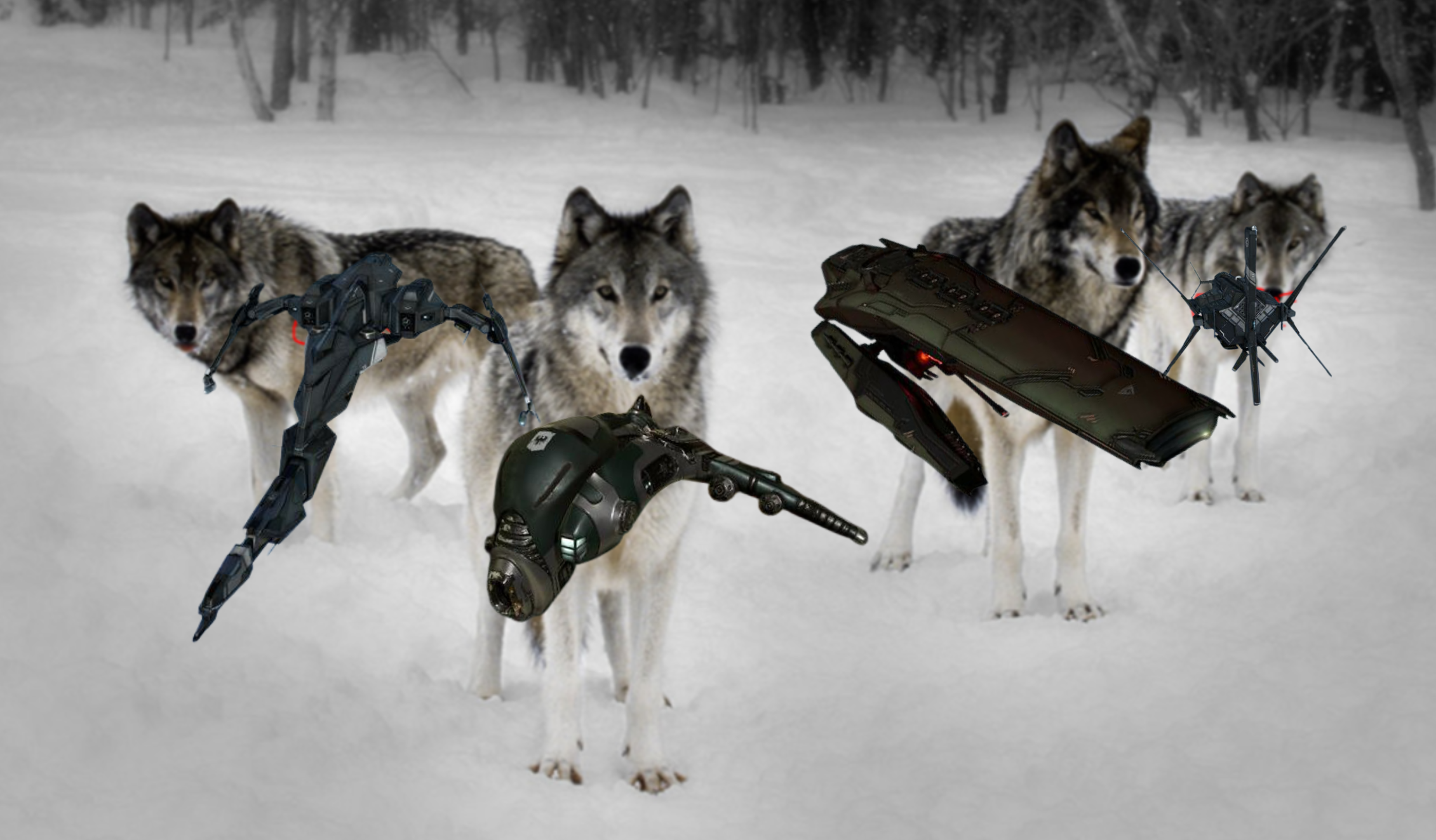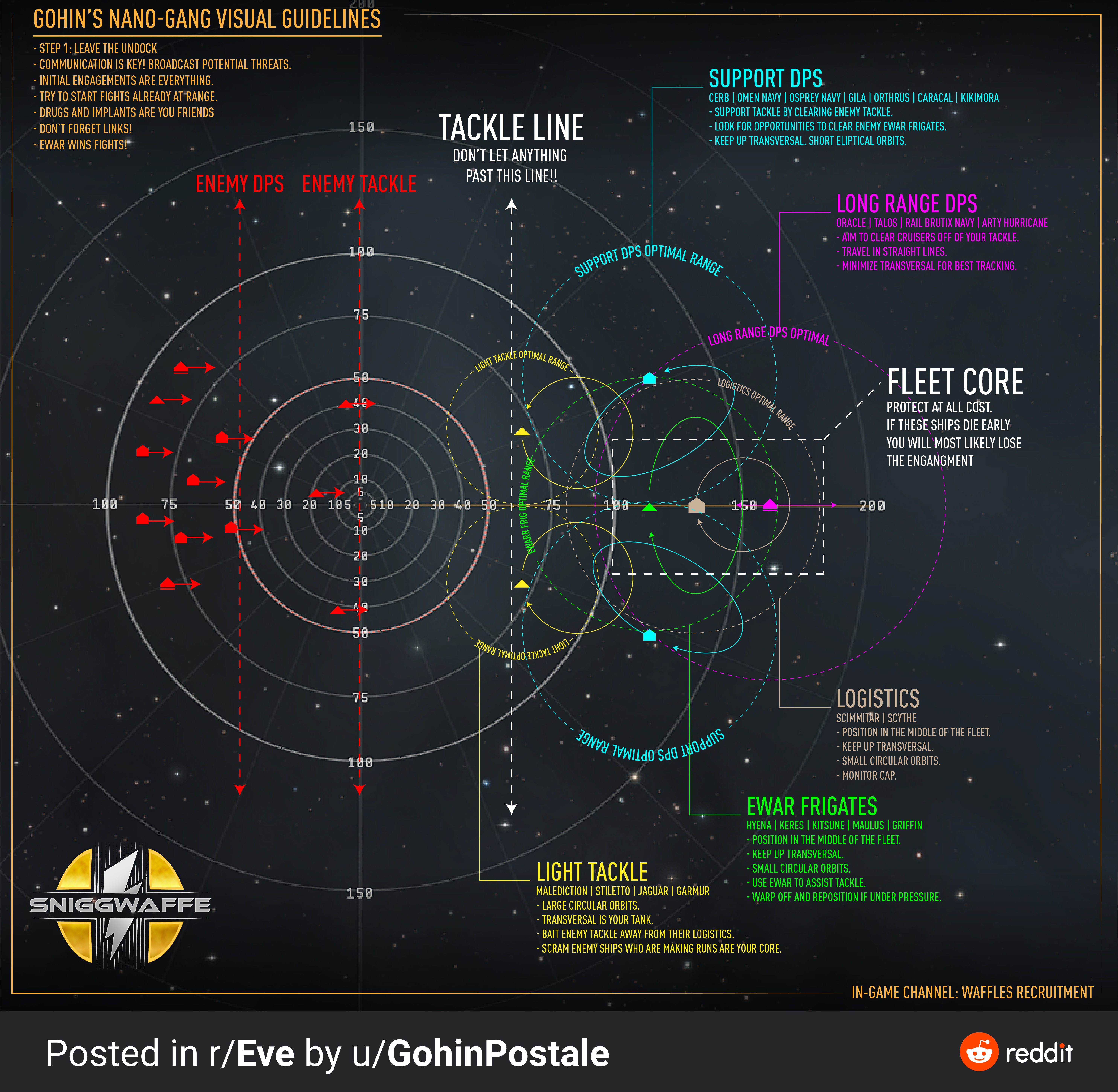Wolfpacks
In the context of home defense and Standing Fleet, Wolfpacks allow us to better defend PVErs, deal with roaming gangs and blops droppers, and act as a Quick Reaction Force (QRF) when hostile gangs make incursions into our space. They also provide smaller scale learning environments with which newer pilots can learn the tools of the trade and become more effective PVPers, and skills can be passed long to them in more controlled environments, rather than the nonstop rush of standing fleet going from one target to the next.
Theory of Operation
Typically, most of standing fleet will stay grouped up within a jump or two of staging. This provides large concentration of force, but low coordination leads to stringing out as the fleet gives chase, with lighter ships getting picked off at the front of the pack while the heavier ships are unable to keep up and arrive too late to participate in the fight. This also leads to outlier systems >2 jumps from Staging being very quiet and poorly defended, resulting in PVErs in those systems being easy targets for hunters and roaming gangs. By piecemealing Standing Fleet into smaller, better organized and more mobile packs, we can increase our response times, which in turn makes our space safer to rat and mine in, and garner valuable practice in small gang fleet tactics and self piloting, skills which translate easily to more capable pilots in larger fleet fights and stratops.
Wolfpacks can start with as few as 5 pilots and as many as 15-20, and the number of wolfpacks operating in Brave space can grow and shrink indefinitely, depending on the time of day and how large standing fleet is at that point. Wolfpacks can also be used as a basis for roaming fleets/presence patrols in the region, allowing us to expand our influence outside of our borders and keep hostiles on their toes.
Wolfpack Components
In sub-20 man fleets/wings, every pilots has a key role to play, no matter how small. As you head out though, its useful to ensure you have a fleet comp that balances mobility, damage, and support (aka control/logistics).
These are by no means hard numbers, but as a general rule your comp should be comprised of at least 50% DPS, no more than 25% tackle, and around 25-30% support.
Mobility refers to the speed and align time of your ships. It would be good to avoid battleships, and stick with the faster Battlecruiser variants, nano fits, and cruiser down, long-range damage dealers. Brawlers can work so long as they move exceptionally fast, and can provide additional heavy tackle on a target once they arrive.
Tacklers are your fastest ships, and the ones that will land initial scrams on any target your pack engages. These can be smallgang interdictors (probing, fleet variants also accepted, but a tackle midslot should be utilized whenever possible), T1/T2 tackle frigates, or even Recons if you want to get fancy.
Support means anything which effects the battlefield without the use of offensive highslot modules (excluding tackle). Examples include Electronic Warfare, which can cause significant impact on a smallgang's ability to fight, and force them to disengate or close the gap in order to apply damage. Long range webbers (aka Huginns/Rapiers), while technically tackle, are able to dictate enemy range and simply by webbing them down to a crawl. Finally there is Logistics, which while less common to see in fleets of this size, nevertheless can be crucial to keeping tacklers alive against "flyswatter" compositions which are designed to kill smaller ships quickly in order to clear tackle and disengage.
Comms
There is normally no need to take a wolfpack to a different comms channel outside of the main standing fleet area, but if you desire a higher degree of coordination, which normally involves much more discussion than is proportional to the people involved, than the designated wolfpack comms channels are available for your use.
If your wolfpack decides to go out on a roam/presence patrol somewhere outside of our borders, its highly recommended to move to one of the fleet comms channel and clear out of standing comms entirely.
Corp System Defense Forces (SDFs)
If you are running a wolfpack or SDF, the Brave Backup Comms server contains standing coordination channels which is used to allow multiple teams to coordinate on a single threat.
Recommended Wolfpack Ship Types
Virtually any ships can participate in a wolfpack, but there's a few key players that can help the pack significantly and maximize the amount of options available for taking fights.
- Ships which can field a hybrid role, such as damage + links (Command Destroyers and Battlecruisers) damage + tackle (Ass Frigs + Combat interceptors) and damage + interdiction (multirole interdictors - Note that the Defender launcher can usually be removed in favor of another gun/launcher for standing fleet use)
- Ships which provide force-multiplier effects, such as Booshers (require EXTREMELY high skill to use in a smallgang environment)
- Ships which can combat probe and tackle become extremely key when enemies start hiding in safes or high perches. Try to have a combat prober in your wolfpack at all times (Examples: Strategic Destroyers, dedicated tackle cruisers, Covert Ops, T3Cs, etc)
While certain doctrines fleet ships can produce good support/damage roles, there's a few guidelines to follow when fitting up
- Microwarpdrives are preferred, as most roaming comps will rely on kiting at extreme speeds moving in excess of 2000m/s. (exception: Sansha hulls)
- Whenever possible, everyone should be carrying some kind of tackle module, unless you are flying something designed to kite at extreme ranges (ex: Oracles, Corms/Rail Hecates, etc).
How to fly in a wolfpack
When first joining a Wolfpack, its useful to ask in comms or the fleet chat/group DM what ship types are needed. If no one can answer that question, join the party in whatever you'd like to fly. Dont feel pressured to be in something blingy or try to do more than your share, you're part of a small team and everyone should be supporting one another to the best of their abilities.
Its ideal for each wolfpack to find its own territory. If you have alts that are typically ratting/mining, find other pilots that are also doing PVE in that area and form a wolfpack. Its very important however, to keep in touch with the rest of Standing Fleet, so that you can support another pack, or they can support you if you suddenly find yourself biting off more than you can chew. If your pack is in a different comms, make sure you have shout keys configured, and that the rest of standing knows your team has moved into a different comms if they need help in that part of our space.
Most fleets roaming in our space will fit into a category known as a "Nano gang". This is a standard composition comprised of ships which are basically designed to run away from a response fleet while swatting away any tackle that burns too far from their friendly support. The general ship types and roles in a nano gang are described in the below infographic.
The biggest threat a standing fleet response will typically face comes from the enemy's support DPS line, also known as their anti-tacklers. These ships are specifically fit up to clear off our tackle so the fleet can disengage at any time. As such, preventing their ability to shoot at our tackle line, by either using ewar to damp down thier targeting range to the point where they are ineffective, or primarying them so they are forced to pull range are some of the tricks that can be used to offensively support your tackle wing.
The next most important tactic for fighting a nano gang is grouping. Staying in a tight group and not allowing faster moving ships to over extend and get caught out on their own is key to keeping the fleet alive. If you are one of the fastest moving ships in the wolf pack, be very careful. In the above inforgraphic you will see the center point of the nano gang where all their weapon ranges converge at the 100km mark. This is the kill zone that you never want to find yourself in alone.
To remember the process for forming a wolf pack, use the following acronym, AMPLE:
Example Comps
None of this represents hard fast requirements or fixed fleet doctrines. These are just example wolfpack layouts which provide well rounded numbers of supports. Most of your ship selection should be based on the enemy composition and numbers, how many pilots and what ship types you need to win the engagement. Generally you want to aim for 1.5x the number of pilots the enemy gang consists of, you can go 1:1 if they are in a low-tier doctrine or you are planning to upship, but try not to go for any greater than twice the enemy strength, at that point if you are still unable to win the engagement you should go back to the drawing board and see if you're flying something which they are "hard countering" or is simply unsuitable for the engagement.
Pico-Gang (3-6 pilots)
Effective Range:
Approx Combined DPS:
DPS
- Caracal (Meta Tripod)
- Caracal (Meta Tripod)
- Cormorant
Support
- Maulus
- Scythe
Tackle
- Atron
Effective Range:
Approx Combined DPS:
DPS
- Drake (HML) (Info Links)
- Caracal (T2 Tripod)
- Caracal (T2 Tripod)
Support
- Bifrost (Shield)
- Keres (Damps + Point)
Tackle
- Stiletto/Ramjag
Effective Range
Approx Combined DPS:
DPS
- Cerberus/Orthrus (RLML)
- Cerberus/Orthrus (RLML)
- Brutix Navy Issue (Skirm)
Support
- Loki/Bifrost (Skirm/Info)
- Huginn
Tackle
- Malediction
Nano-Gang (8-10 Pilots)
Effective Range:
Approx Combined DPS:
DPS
- Cyclone (Info/Skirm)
- Caracal
- Caracal
- Caracal
- Talwar
- Talwar
- Talwar
Support
- Scythe
- Scythe
Tackle
- Atron
- Slasher
Effective Range:
Approx Combined DPS:
DPS
- Cyclone (Skirm/Shield)
- Scythe Fleet Issue
- Scythe Fleet Issue
- Scythe Fleet Issue
- Shield Vedmak
- Shield Vedmak
Support
- Hyena (Web)
- Keres (Damps + Point)
- Scythe
- Scythe
Tackle
- Malediction
Effective Range:
Approx Combined DPS:
DPS
- Sleipnir (Shield
- Naga
- Naga
- Omen Navy
Support
- Huginn
- Lachesis
- Scimitar
- Scimitar
Tackle
- Malediction
- Sabre (smallgang fit)
15-20 Pilots
Effective Range: 20km
Approx Combined DPS: 4000
Unique Feature: 28 scram strength combined
DPS
- Thorax
- Thorax
- Thorax
- Thorax
- Algos
- Algos
- Thrasher (Cockbag)
- Thrasher (Cockbag)
- Catalyst
- Catalyst
- Catalyst
Support
- Griffin
- Griffin
- Blackbird
- Blackbird
Tackle
- Atron
- Atron
- Atron
- Stabber
- Stabber
DPS
Support
Tackle
DPS
Support
Tackle
Vultures
As a wolfpack defends its territory and kills its game, vultures are inevitably attracted to take advantage of a free meal. In this context however, we are referring to PVE activities which occur in the same system as a wolfpack. Anyone following a wolfpack to take advantage of the relative safety and QRF capabilities they can offer can earn isk. (?)
Recommended practices when taking advantage of the cover of a wolfpack fleet include, but are not limited to:
- Being in comms with your respective wolfpack, whether they are in main comms or one of the wolfpack mumble channels.
- Be aware of what the wolfpack is doing at all times. Its important to know if they are fighting, moving out of system to support another wolfpack, part of our space, or to go on a roam, dismantling/standing down, or if a fleet too big for them to handle enters system.
- If you are capable of multiboxing, providing some sort of PVP support, even minor, such as an EWAR or Tackle frigate can improve the Wolfpack's capabilities and provide a stronger deterrence for anyone looking to score some easy kills.

